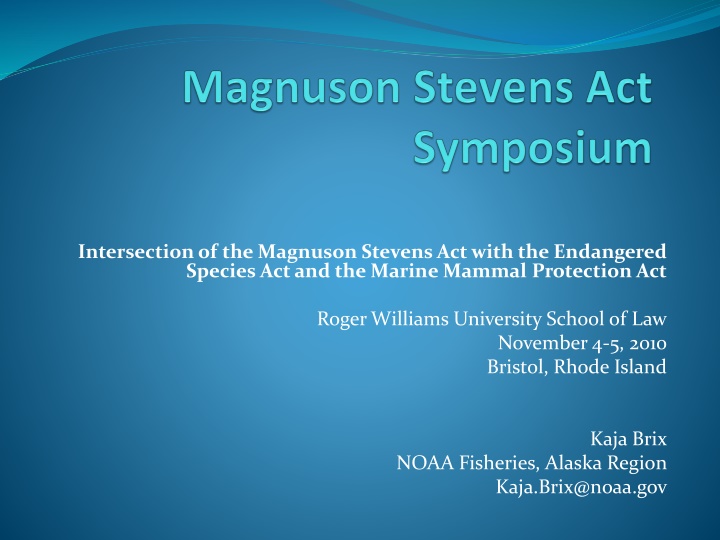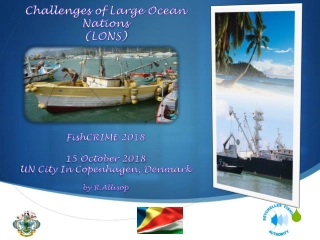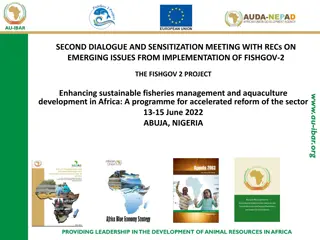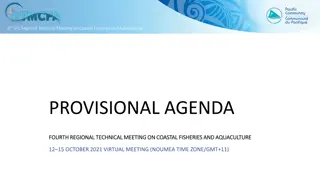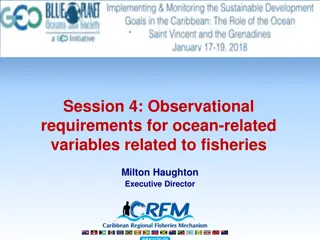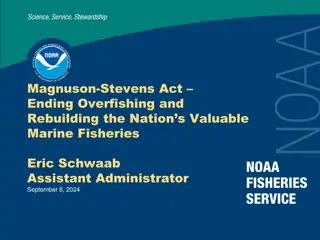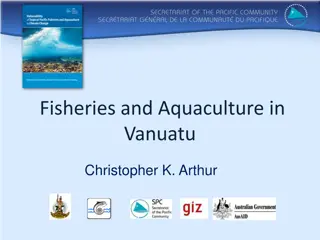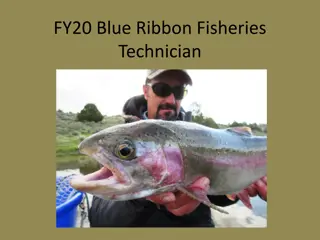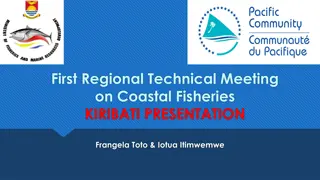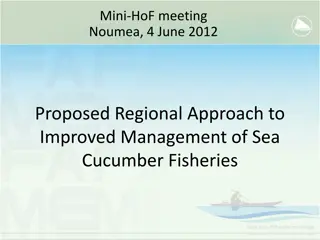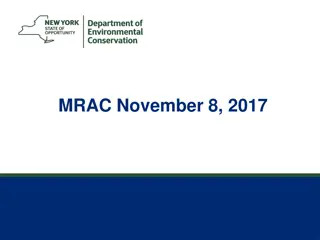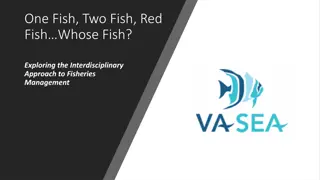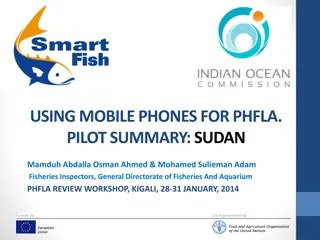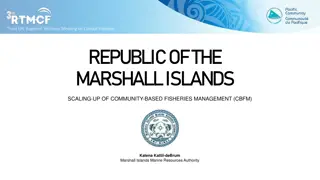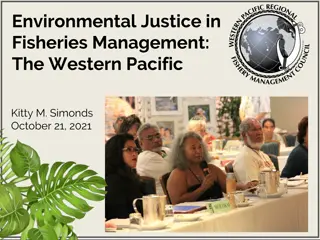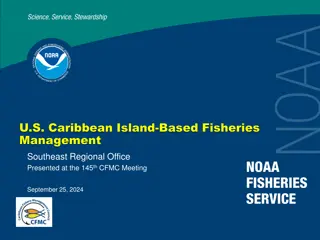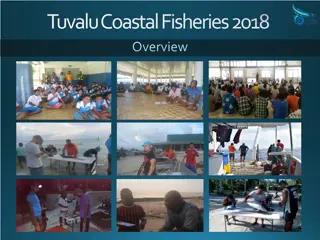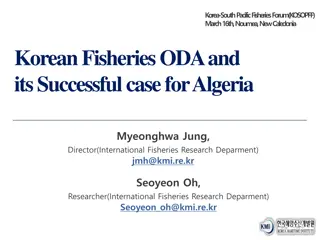Ecosystem Considerations in Fisheries Management Laws
Analysis of the intersection of the Magnuson Stevens Act, Endangered Species Act, and Marine Mammal Protection Act in addressing ecosystem considerations within fisheries management. Evaluation of current regulatory frameworks and the need for an ecosystem-based approach towards fisheries and apex predators.
Download Presentation

Please find below an Image/Link to download the presentation.
The content on the website is provided AS IS for your information and personal use only. It may not be sold, licensed, or shared on other websites without obtaining consent from the author.If you encounter any issues during the download, it is possible that the publisher has removed the file from their server.
You are allowed to download the files provided on this website for personal or commercial use, subject to the condition that they are used lawfully. All files are the property of their respective owners.
The content on the website is provided AS IS for your information and personal use only. It may not be sold, licensed, or shared on other websites without obtaining consent from the author.
E N D
Presentation Transcript
Intersection of the Magnuson Stevens Act with the Endangered Species Act and the Marine Mammal Protection Act Roger Williams University School of Law November 4-5, 2010 Bristol, Rhode Island Kaja Brix NOAA Fisheries, Alaska Region Kaja.Brix@noaa.gov
The Magnuson Stevens Act and Protected Species Management
US Ocean Policy Adopt ecosystem-based management as a foundational principle for the comprehensive management of the ocean, our coasts, and the Great Lakes. President Obama s US Ocean Policy (Objective) 2010 Pew Commission report and Oceans Commission report point to the need for changes in the organization of fisheries and ocean management to institutionalize ecosystem considerations in policy making. --Pew 2003; US Commission on Ocean Policy 2004
The Magnuson Stevens Act, the Endangered Species Act and the Marine Mammal Protection Act How do these laws currently address ecosystem considerations? Do the laws intersect? Are we taking an ecosystem approach to the management of fisheries and apex predators?
Magnuson Steven Act Purpose: 1) to take immediate action to conserve and manage the fishery resources off the coasts of the United States, by exercising A) sovereign rights for the purposes of exploring, exploiting, conserving and managing all fish within the exclusive economic zone [ ]. Section 301 National Standards for Fishery Conservation and Management (1) achieve on a continuing basis the optimum yield from each fishery for the US fishing industry MSFCMA Section 303(b) DISCRETIONARY PROVISIONS. Any fishery management plan which is prepared by any Council, or by the Secretary, with respect to any fishery, may (12) include management measures in the plan to conserve target and non- target species and habitats, considering the variety of ecological factors affecting fishery populations.
Magnuson Stevens Act In practice fisheries management is a maximum yield approach for single species management of fish stocks From Goodman et al. 2002: The current harvest strategy is essentially an msy single species approach, modified by some formal safeguards incorporated to ward against overfishing as defined from a single species standpoint and with opportunities of a less-structured nature for reducing harvest rates further in response to perceived social, economic and ecological concerns. No quantitative standards or specific decision rules are stated for each of these latter considerations except as they are imposed from outside by the MSA, by the ESA or the MMPA.
Magnuson Stevens Act Ecosystem Considerations Ecosystem Committees for Fisheries Management Councils Stock Assessment Reports in Alaska include Ecosystem chapters Prohibitions on directed fishing on forage fish complex (North Pacific) and krill (Pacific) Prohibited fishing in the Arctic- new FMP In general, these are non-specific actions focused at or below the trophic level harvested by the fisheries.
Marine Mammal Protection Act Congress finds that- certain species and population stocks of marine mammals are, or may be, in danger of extinction or depletion as a result of man s activities; such species and population stocks should not be permitted to diminish beyond the point at which they cease to be a significant functioning element of the ecosystem of which they are a part they should not be permitted to diminish below their optimum sustainable population [ ].
Endangered Species Act Purpose: To provide a means whereby the ecosystems upon which endangered species and threatened species depend may be conserved [ ]. Policy: It is the policy of Congress that all Federal departments and agencies shall seek to conserve endangered species and threatened species and shall utilize their authorities in furtherance of the purposes of this Act.
Endangered Species Act Section 7(a)(1): all other federal agencies shall utilize their authorities in the furtherance of the purposes of this Act by carrying out programs for the conservation of endangered species and threatened species listed pursuant to section 4 of this Act. Section 7(a)(2): each Federal agency shall insure that any action is not likely to jeopardize the continued existence of any endangered species or threatened species or result in the destruction or adverse modification of habitat of such species [ .]
Consultations on Federal Fisheries Actions under the ESA (Section 7) Fisheries actions are ongoing actions reauthorized on an annual basis Consultations under the ESA are thereby periodic when new information may indicate a new impact The challenge under section 7(a)(2) --fishery is modified- if- it results in a circumstance whereby it jeopardizes the continued existence of the ESA listed species or destroys or adversely modifies its critical habitat.
The MMPA and the ESA Both recognize that human activities can place a detrimental burden on vertebrate species Both legislate societal values for conservation of vertebrate species and their habitat Different standards: optimum sustainable populations (MMPA) or risk of extinction i.e. ones in need of critical care (ESA) Different mechanisms for addressing these standards
How well does Ecosystem management work? Fisheries management has moved to include ecosystem management only to the extent that it has improved single species models for fish; not for apex predators who may feed on nodal (often commercial) species. Is this Ecosystem Management? Better integration--Should we be using 7(a)(1) under the ESA instead of 7(a)(2)?
Ecosystem Management: Integration of Apex Predators in Fisheries Management MMPA optimum sustainable population (?) ESA 7(a)(1): Agencies shall utilize their authorities for the conservation of endangered and threatened species. If we wait to consult on ongoing fisheries under 7(a)(2) we have waited too long. Instead we should be aiming to accommodate apex predator needs in fisheries exploitation models i.e. 7(a)(1). Need to require under the MSA modifications to single species msy fisheries management to effectively manage at the ecosystem level
